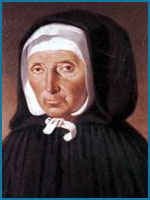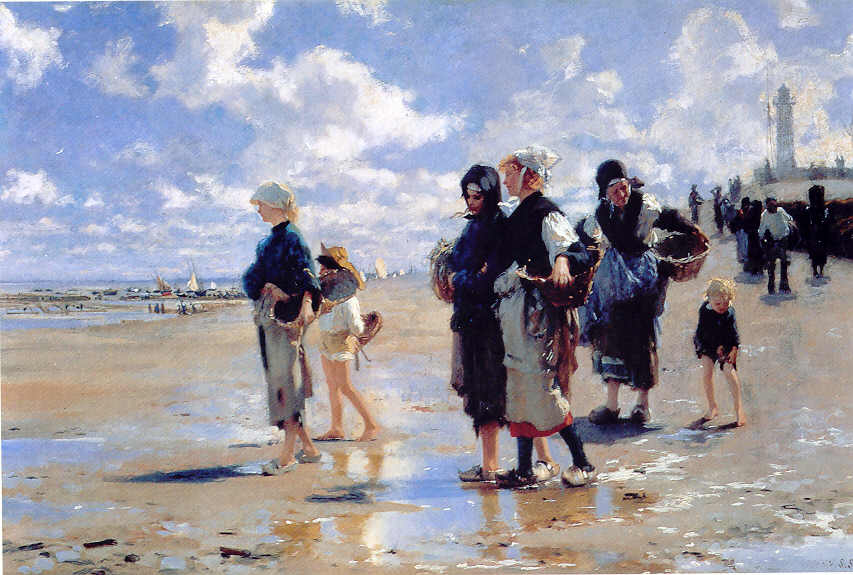Oyster
Gatherers of
Cancale
John Singer
Sargent -- American
painter
1878
Corcoran
Gallery of Art,
Washington DC.
Oil on canvas
96.8 x
123.2 cm (31 1/8
x 48 1/2 in.)
(Click on image to step
closer)
Located on the west
bay of Mont-Saint-Michel,
in the extreme northeast of Brittany, the Village of Cancale has been
tied
to the sea for centuries -- well before the time of Christ -- and
is known for its stunning breakers, its rocks, its breathtaking vistas,
its beaches, and of course the living gold it breaths forth --
its
mouthwatering oysters. Its people, the Cancalaises, were known for
their
stoic courage and resilience against a coastline and a way of life that
could be as heartlessly unforgiving as it was ruggedly breathtaking,
ever-changing,
and wildly beautiful.
Three
days of arid Paris contain less delights than one Cancalaise hour.
-- Colette
When Sargent
visited there in 1877,
many of the men were away -- as they would often be through the
nineteenth
century -- sailing far into the ocean bound for the rich fisheries of
Newfoundland,
gambling big on a catch that might pay handsomely. Fathers, sons,
brothers,
sometimes many of the eligible men in a household might be gone for as
long as six months from spring till fall.
In their absence,
and left to their
own resources, the women and children could not live on promises of a
Newfoundland
catch alone. What they did have, however, were conditions along a
coastline
that were so unusual, that as far back as the Romans, the area had been
harvested for oysters.
Displayed with more
than a little
notice at the 1878 Paris Salon (see
Road to Madame X), "Oyster Gatherers of Cancale" by a young,
relatively
unknown twenty-two year old American, was from the very beginning more
than just a pretty sentimental picture; more than the artful handling
of
a cumulus-clouded sky on a beach with nameless natives; and more than
just
the skillful play of light in the reflective pools at their feet by a
clever
young foreigner; to the French who had been there; to the ones that
understood
the Cancalaises, this painting cut directly to an understanding beyond
his years and beyond an outsider's view, right to the very inner soul
of
a Cancalaiser's life.
In the summer of
1877, when the men
were absent (say for a few -- see background right) the women would
come
down from the village, having passed the village's lighthouse at
point Cale. We are seeing a number of generations -- a grandmother,
some
young mothers, and children on their way to the oyster beds, baskets in
hand and children in tow. They wear the traditional dress of the white
headscarf and wooden shoes. The center women, dressed in black, appears
to be in a nuns habit similar to what was worn by Jeanne Jugan who
founded
"Les Petites Sœurs des Pauvres" (little sisters for the poor)
in
Saint-Malo.

Jeanne
Jugan
(Cancale 1792 Saint-Malo 1879)
Artist?
jpg:
ville-saint-malo
Although
impressionistic and with
the method of Carlous-Duran that painted figures with little to no
drawing
and outlining, the spontaneity of figures and freshness of his brush
belies
the very calculated composition that Sargent presents. Back at his
studio
in Paris, he worked relentlessly on this pulling a whole host of
sketches
together -- starting -- stopping -- pacing back and forth with that
manic
energy -- frustrated -- a hand pulling on his beard -- a furrowed
brow -- muttering under his breath -- pitching the entire thing and
re-attacking
again until he could do it from his gut -- quick -- fresh strokes --
sure
and unquestioning -- until . . . .
Until he had
exactly what he wanted.
For Sargent,
"Oyster Gatherers of
Cancale" would forever be a seminal moment in the evolution in his art.
What he would learn here, he would use over and over to teach students
at the Royal Academy in later years. The matrix of complexity from
composition,
to handling of paint, to the power of light were all here! For
Sargent, "Oyster Gatherers" defined his style.
Nothing
was left to chance. Nothing replaced hard work. Nothing excused
anything
short of a total understanding and empathy for his subject. And nothing
-- NOTHING -- substitute practice -- and more practice
until
his brush was the completely-tuned extension of his mind.
Note:
Special thanks to
Madeleine Bruchet,
who's parents lived in Cancale, and a friend
of the JSS Gallery, and for her big help with this page on
Cancale.
Exhibitions
John Singer Sargent,
An Exhibition -- Whitney
Museum, NY & The Art Institute of Chicago 1986-1987
|

